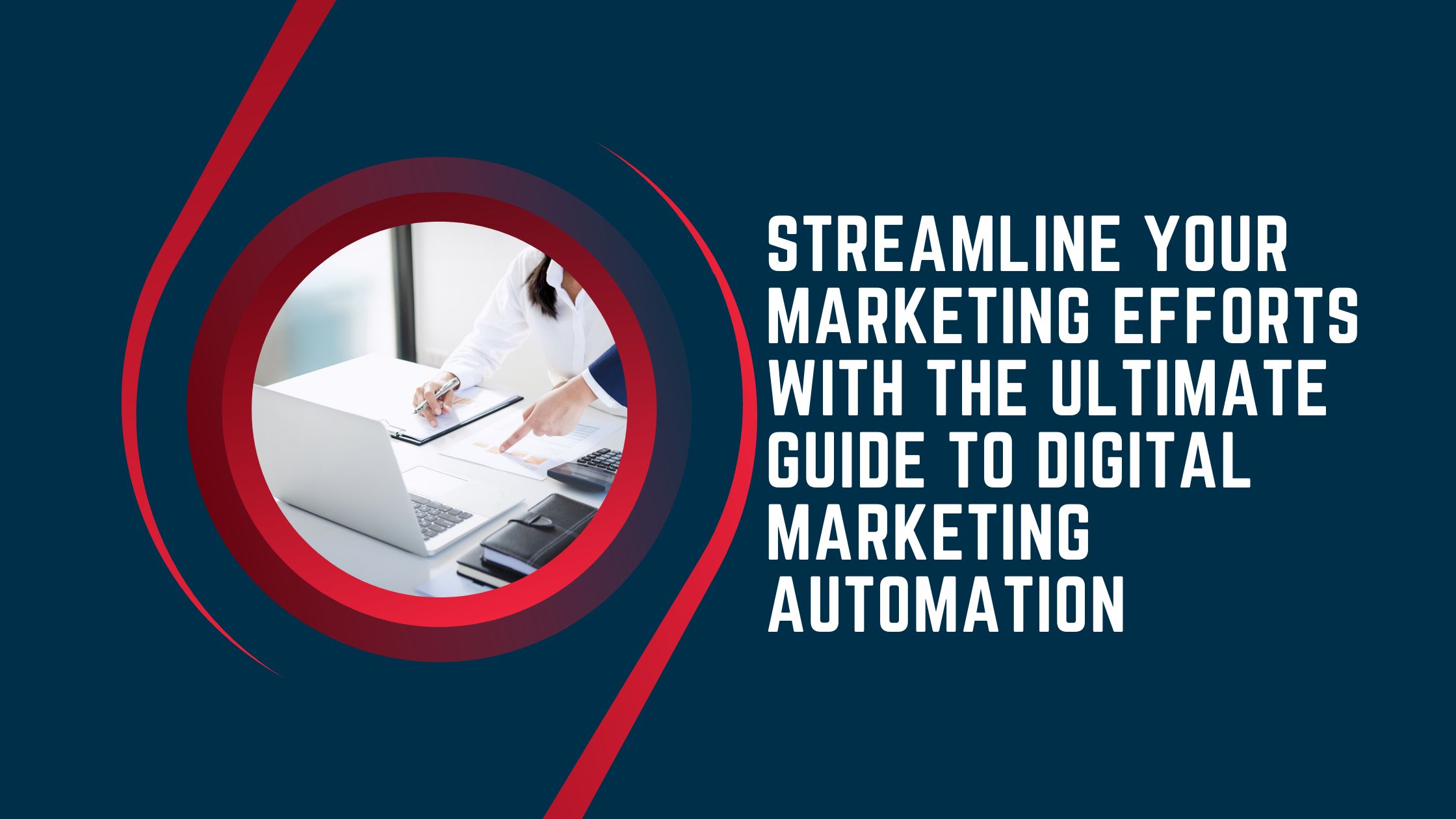Streamline Your Marketing Efforts with the Ultimate Guide to Digital Marketing Automation
Are you tired of spending countless hours on repetitive marketing tasks that drain your time and energy? Do you want to streamline your marketing efforts and achieve better results with less effort? Look no further than digital marketing automation. With the help of cutting-edge technology, automation can help you save time, improve efficiency, and boost your ROI.
In this ultimate guide to digital marketing automation, we’ll explore everything you need to know about this game-changing tool – from its benefits to best practices for implementation – so you can take your business to the next level. Let’s get started!
What is Digital Marketing Automation?
Digital marketing automation is the process of using software to automate marketing tasks. It can help you save time and money by automating repetitive tasks, such as email marketing, social media campaigns, and targeted content creation. By automating these tasks, you can free up your time to focus on more important aspects of your business.
Digital marketing automation can be used for a variety of tasks, including:
–Email marketing: Automatically send out emails to customers and prospects based on certain criteria, such as when they sign up for your list or make a purchase.
–Social media campaigns: Automate your social media posts and campaigns so that they are published at the optimal times and target the right audience.
–Content creation: Use software to create and publish targeted content that is designed to attract leads and convert them into customers.
Benefits of Automating Your Digital Marketing
Digital marketing automation can save you time and money while helping you to better target your audience with more relevant content. By automating your digital marketing efforts, you can free up time to focus on other areas of your business while still maintaining a strong online presence.
Additionally, automating your digital marketing can help you to collect data and track results more effectively, allowing you to make necessary adjustments to improve your ROI.
Types of Digital Marketing Automation Solutions
Digital marketing automation solutions come in all shapes and sizes. Here are a few of the most popular types:
1. Email Marketing Automation
Email marketing automation allows you to automate your email marketing campaigns, including things like welcome emails, lead nurturing emails, cart abandonment emails, and more. This can save you a ton of time and help you stay in touch with your customers on a regular basis.
2. Social Media Automation
Social media automation tools help you manage your social media accounts and schedule posts ahead of time. This can be a huge time-saver, especially if you’re managing multiple accounts.
3. Lead Management Automation
Lead management automation tools help you capture leads from your website and track their progress through your sales funnel. This helps you stay organized and follow up with leads in a timely manner.
4. Customer Relationship Management (CRM) Integration
Many digital marketing automation solutions offer CRM integration, which allows you to automatically add new contacts to your CRM database and keep track of all your customer interactions in one place. This can be a massive time-saver for businesses that rely heavily on their CRM for sales and marketing operations.
The Steps to Designing an Effective Automated Digital Marketing Plan
1. Define your target audience: Who are you trying to reach with your digital marketing automation? You need to have a clear understanding of your target audience before you can create an effective plan.
2. Research your competition: What are they doing that’s working? How can you do it better? You need to know what’s already out there before you can create a plan that will work for you.
3. Set some goals: What do you want to achieve with your digital marketing automation? Without some goals, it’ll be hard to measure your success.
4. Choose the right tools: There are a lot of different options out there when it comes to digital marketing automation tools. You need to choose the ones that will work best for you and your team.
5. Create a workflow: Once you have the tools in place, you need to figure out how they’ll work together. What tasks need to be completed in what order? This is where a lot of trial and error comes in.
6. Automate as much as possible: The more you automate, the less time you’ll spend on menial tasks. But beware of automating too much–you don’t want to lose the personal touch that can make digital marketing so effective.
7. Test, test, test: Always be testing different aspects of your plan to see what works and what doesn’t. There’s no one-size-fits-all solution, so what works for someone else might not work for you.
8. Analyze and adjust: Keep track of the results you’re getting and make adjustments as needed. If something isn’t working, try changing it up until you get the results you want.
9. Refine and repeat: Once you have your plan in place, don’t just set it and forget it. Make sure to refine things as needed and keep track of results so that you can continue to improve over time.
By following these steps, you can create an effective automated digital marketing plan that will help you reach your goals and grow your business.
Tips and Best Practices for Setting Up and Using Digital Marketing Automation Tools
Digital marketing automation tools can save you time and money by automating repetitive tasks and freeing up your staff to focus on more strategic tasks. Here are some tips and best practices for setting up and using these tools:
1. Define your goals and objectives. What do you want to achieve with digital marketing automation? More leads? More sales? More web traffic? Once you know what you want to achieve, you can select the right tools and set them up accordingly.
2. Choose the right tool for the job. There are many different digital marketing automation tools available, so it’s important to choose one that fits your needs. If you’re not sure which tool to use, ask for recommendations from other businesses or consult with a digital marketing expert.
3. Set up your tool properly. Once you’ve selected a digital marketing automation tool, take the time to set it up correctly. This includes configuring the settings, adding users, and integrating it with other software applications (such as your CRM).
4. Train your staff on how to use the tool. Your staff will need to know how to use the digital marketing automation tool in order to get the most out of it. Make sure they understand all of the features and capabilities of the tool, and provide them with any training materials they may need.
5. Monitor results and adjust as needed. Digital marketing automation is not a set-it-and-forget-it solution – you’ll need to monitor the results and adjust as needed. This includes testing different messages, optimizing campaigns, and analyzing data to see how your efforts are paying off.
6. Integrate with other digital marketing tools. Digital marketing automation works best when it’s integrated with other digital marketing tools, such as email marketing and social media management platforms. This will help you get even more out of your automation efforts.
7. Automate wisely. Automating too many tasks can lead to oversaturation of messages, so be sure to prioritize which tasks should be automated first based on importance and impact on overall business goals.
Examples of Successful Automated Digital Marketing Campaigns
If you’re looking to streamline your marketing efforts and get the most out of your digital marketing budget, automation is key. By using marketing automation tools, you can more effectively target your audience, schedule your content, and measure your results.
Here are some examples of successful automated digital marketing campaigns:
1. The British Heart Foundation’s ‘Heart Age’ Campaign
The British Heart Foundation’s ‘Heart Age’ campaign used a combination of email marketing, online advertising, and social media to raise awareness of the importance of heart health. The campaign was highly successful, reaching over 22 million people and resulting in 1.2 million people taking the online heart age test.
2. Greenpeace’s ‘Save the Arctic’ Campaign
Greenpeace’s ‘Save the Arctic’ campaign used email marketing, online petitions, and social media to raise awareness of the threats to the Arctic environment. The campaign was successful in mobilising over 7 million people to take action on this issue.
3. UNICEF’s ‘Change for Good’ Campaign
UNICEF’s ‘Change for Good’ campaign used a combination of email marketing, online donations, and social media to raise money for children in need around the world. The campaign was highly successful, raising over $18 million dollars.
Conclusion
Digital marketing automation can help you save time and resources, allowing you to focus on more creative and effective marketing strategies. By implementing the tips outlined in this guide, you’ll be able to reduce costs associated with manual tasks, generate more leads, increase conversions rates and customer loyalty.
Once your digital marketing processes are automated, all that’s left is for you to monitor them and measure their effectiveness. With a well-implemented digital marketing automation system in place, your business will be well on its way towards becoming even more successful!




